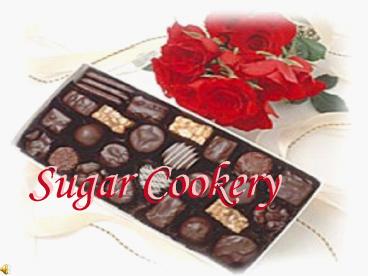Sugar Cookery - PowerPoint PPT Presentation
1 / 15
Title:
Sugar Cookery
Description:
Step 3: cook to desired temperature and color; add cream of tartar, butter, ... We've already learned 4 different ways to prevent the formation of large sugar ... – PowerPoint PPT presentation
Number of Views:2097
Avg rating:3.0/5.0
Title: Sugar Cookery
1
Sugar Cookery
2
Sugar Cookery...
It is based on the changes that take place when
sugar is...
A. cooked at different temperatures
B. cooked in combination with various ingredients
3
There are basically 2 types of candy...
CRYSTALLINE candy contains sugar crystalsvery
small sugar crystals! These small crystals
create a smooth and creamy texture. While making
this candy, you must take every precaution to
avoid the formation of large crystals. Examples
are fudge, fondant, or divinity
NON-CRYSTALLINE candy has no crystal formation.
These candies may be chewy or brittle. Examples
are peanut brittle, toffee, or caramels
4
4 ways to keep sugar crystals from forming...
A. Heat mixture to a very high temperature
B. Avoid stirring crystalline candy
- Avoid too much sugar for the amount of liquid
- (overcooking evaporates liquid)
D. Add a substance that interferes with
crystallization
1. Corn syrup
2. Milk or cream
3. Butter
4. Cream of tartar
5
Steps in cooking the candy...
Step 1 combine liquid and sugar start heating
Step 2 Bring to boiling as liquid evaporates
temperature will continue to rise
Step 3 cook to desired temperature and color
add cream of tartar, butter, flavorings, and
other ingredients as called for
6
Cooking tips...
To CARMELIZE sugar means to melt it. The sugar
will be clear when it first melts, but quickly
turns amber in shades from light to dark brown.
When making candy, choose a pan that is VERY
HEAVY. This helps prevent scorching. A cast iron
pan is really good for this.
Before beating a crystalline candy, allow it to
cool until you can comfortably hold your hand on
the bottom of the pan WITHOUT BURNING IT!
Air and ointment heal burns. Avoid bandages when
possible.
7
More sugar crystals?
Your crystalline candy is finally done, and its
perfect so far!
Put that rubber spatula back in the draweryou
cant use it for scraping the candy pan!
Weve already learned 4 different ways to prevent
the formation of large sugar crystals, but there
is a 5th. DO NOT SCRAPE THE PAN! Simply pour the
candy from the pan as much as possible, and stop.
Scrapings cause crystals!
8
Is the candy done?
There are two ways to check your candy and see if
it is done
1. Use a cold water test get a cup of very
cold water and drizzle a small amount of the
candy mixture into the water with a spoon the
candy mixture will progress through 6 different
stages that can be detected by observing and
picking up the cooled residue in the cup of water
2. Use a candy thermometer the thermometer must
be attached to the side of the pan with the bulb
submerged in the mixture but not touching the pan
itself (you want to see the temperature of the
mixture, not of the pan) watch constantly as
the right temperature comes near caution the
thermometer itself may get hot!
9
Temperatures and cold water tests...
230 234 degrees syrup forms a ____________
(pancake syrup) 234 240 degrees syrup forms a
____________ (fudge fondant) 244 248
degrees syrup forms a ____________ (chewy
caramels) 250 266 degrees syrup forms a
____________ (marshmallows) 270 290
degrees syrup will ________________
(butterscotch taffy) 300 310 degrees syrup
will ________________ (brittle) 320
degrees sugar melts and becomes
_______________ (clear liquid) 338 degrees
sugar is __________________ (brown liquid)
thread
soft ball
firm ball
hard ball
soft crack
hard crack
liquid
burnt
10
Dipping candies in coatings such as chocolate was
traditionally done on a stone slab with the
hands. Use butter on your hands when handling
hot candy to help prevent burns.
Dipping candy...
A few shavings of paraffin wax can be added to
dipping chocolate. This provides a glossy
appearance and keeps the coating from melting
quite so easily in your hands.
Paraffin wax catches on fire easily. You may want
to consider using a product called almond bark
instead.
Almond Bark comes in white or dark chocolate
flavors. It melts quickly and smoothly and is
safe to use.
11
Handling candy...
You may have to handle hot candy with your hands,
such as when forming shapes (dipping chocolates
or popcorn balls) or perhaps when pulling taffy.
Use butter or powdered sugar to coat your hands
and avoid burns. Do NOT use products such as
shortening, flour, or cornstarch as they may add
unpleasant flavors to candy.
12
Melt chocolate carefully...
You may want to melt chocolate in a microwave or
double boiler to prevent scorching. Be careful
chocolate is made up of dry particles (cocoa and
sugar) and fat (cocoa butter). Just a drop or
two of water or even steam may moisten the dry
particles, causing them to cling together in a
dull, dry, and grainy mass. This is called
SEIZING.
13
Refined Sugars...
Granulated sugar (table sugar), brown sugar, and
confectioners sugar (powdered sugar) are made
from sugar cane or sugar beets. These are
examples of sucrose.
Maltose is the sugar from grain products.
Lactose is milk sugar.
Maple syrup and molasses.
Fructose is fruit sugar.
Corn syrup Honey
14
The End
15
- Preparing individuals for life and work
- Strengthening families
- Empowering communities
- Created by Barbara L. Swarthout, Family
Consumer Sciences teacher at Elkhorn High School































